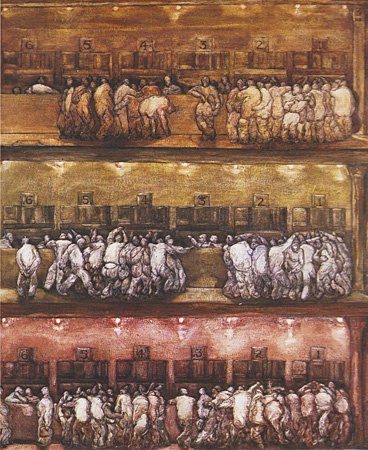Cultural Center of the Philippines
ENCYCLOPEDIA OF
PHILIPPINE ART
Jai-Alai Series
1974-90 / Multiple works / Oil on canvas / Various dimensions / Initial works in the series were first exhibited at the Gallery, Regent of Manila, 1978 / Artist: Danilo E. Dalena / In various collections
Danilo Dalena began to work on the Jai-alai series in 1974, and the first set of paintings from this series was exhibited in 1978. However, even after this exhibit, Dalena continued to paint works on the same subject. Two works from this series won prizes: Tres-Seis Dejado, 1974, first prize, Art Association of the Philippines; and Jai-alai as Metaphor, 1980, grand prize, Mobil Art Awards.
Jai-alai is a type of ball sport known for its speed. Moreover, the sport involves many types of betting, which require predictions on the score outcomes or comparative standing of players and/or teams at the end of the games. Jai-alai is a very popular gambling sport, just like horse racing. In the Jai-alai series, Dalena does not deal with the players or the excitement of the game, but the betting that is done around it. He is therefore interested in depicting people in the fronton, specifically understood as the wall where the ball is hurled at, but also more generally used to mean the entire area where the jai-alai event happens inclusive of the audience hall and betting stations. Dalena often portrays these spaces as filled with bodies, scattered, lined up or massed close to each other, yet each one seemingly indifferent to what is really happening to the other, their sights locked expectantly on the results of the game. In Event 13, 1978, for example, the people are in the stands, but visibly in a state of anxious impatience and unease. Some are sprawled clumsily on their seats, bored or dozing off; while others are hanging on to the bars, making mindless conversation while waiting for the results of the games. Opening, 1996, on the other hand, shows a swirl of entangled bodies gushing forth from the entrance to get seats as the games open. In all these instances, the bodies are rendered schematically, as faceless and rounded forms reduced to anonymity, perhaps the preferred state that each wants to be to others.
Art critic and historian Alice Guillermo remarked on how the betting hall in Dalena’s works may be seen as a metaphor of the human condition, particularly for Philippine society in a state of crisis. Dalena himself admits to having been a habitué of the fronton at one point when he found himself out of work. It is therefore not difficult to understand how gambling can become recourse in “search of luck or miraculous relief.” It is this which Dalena satirizes in his Jai-alai series. For against images of a multitude of bettors, it is rare that one finds a winner (llamado). Instead, there are scores of losers, the talunan or the dejado. In Talo, 1989, for example, a loser leans his head against the wall, as if to take comfort, where there is none, in his own shadow. Betting slips are strewn all over the floor, gnawing reminders of the once liquid cash now turned into litter. The palette’s earthy or muted hues echo this forlorn feeling. Yet strangely, Dalena does not leave one feeling totally wasted. Details of the sordid can occasionally make one laugh. Did they just pull up that one body from the crowd over the balcony? Is that person in the audience hall trying to pick that other person’s bag? Is a couple there in fact, sharing intimacies? It is perhaps these little things that Guillermo notes as Dalena’s “sly left-handed compliments,” which make him so much part of what he satirizes.
Written by Marilyn R. Canta
Sources
Casin, Pam Brooke. 2008. “Danilo Dalena: The Inquisitive and Contemporary Visual Genius.” Manila Bulletin, 27 Oct, G4.
Guillermo, Alice G. 1990. Danilo Dalena: A Survey of His Works. Manila: Coordinating Center for the Visual Arts, Cultural Center of the
Philippines.
Labrador, Ana P. 2000. 13 Painters for the 21st Century. Sikat Books.
